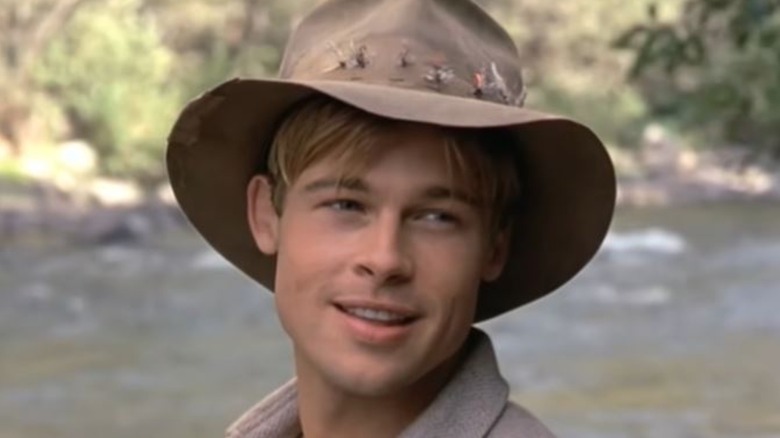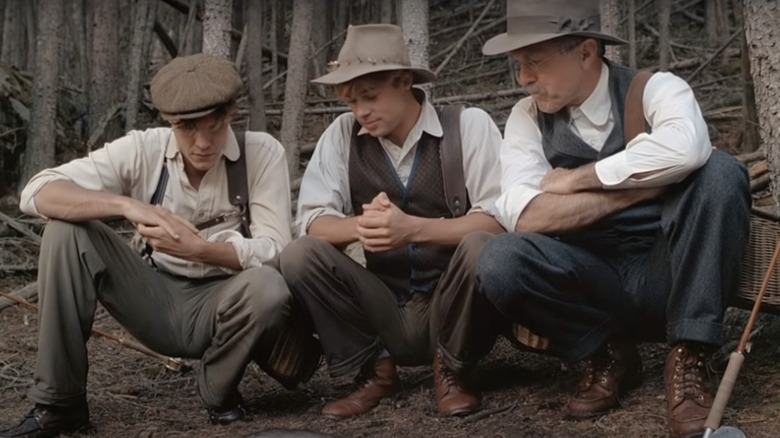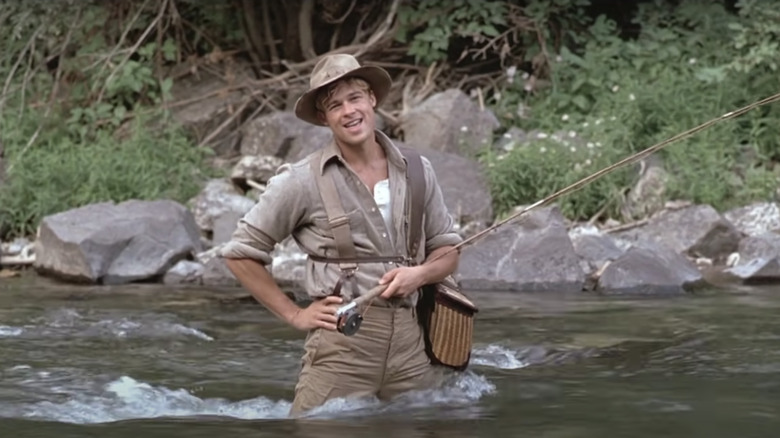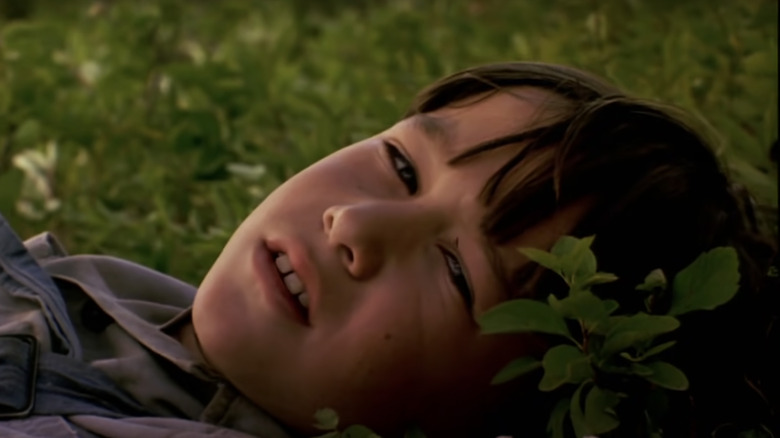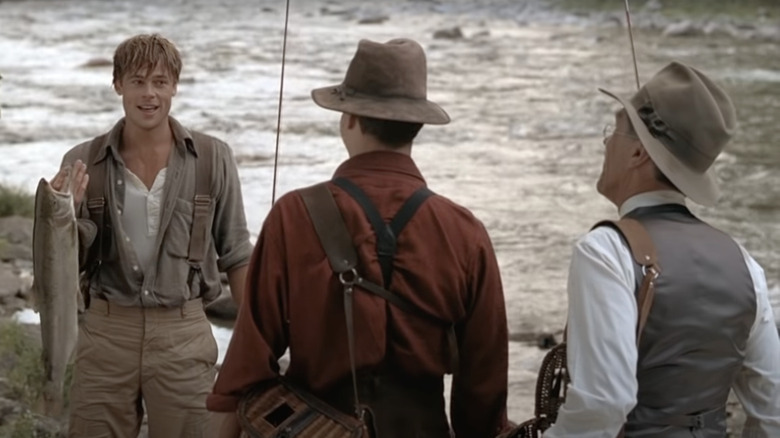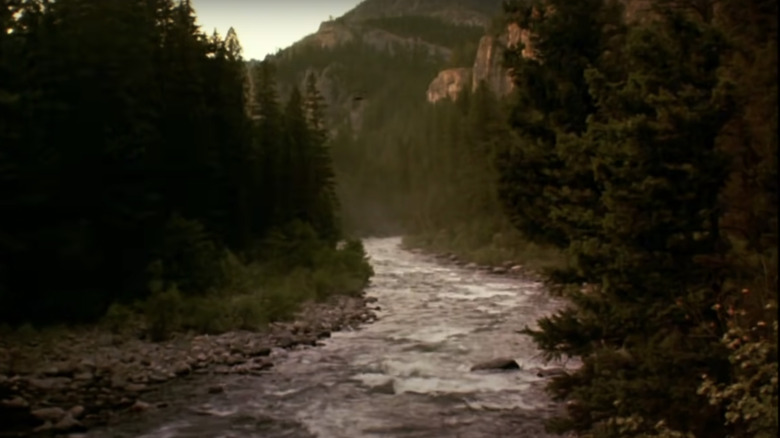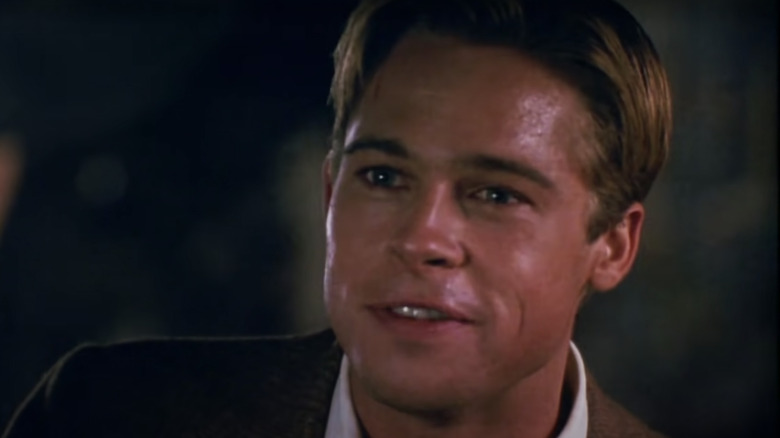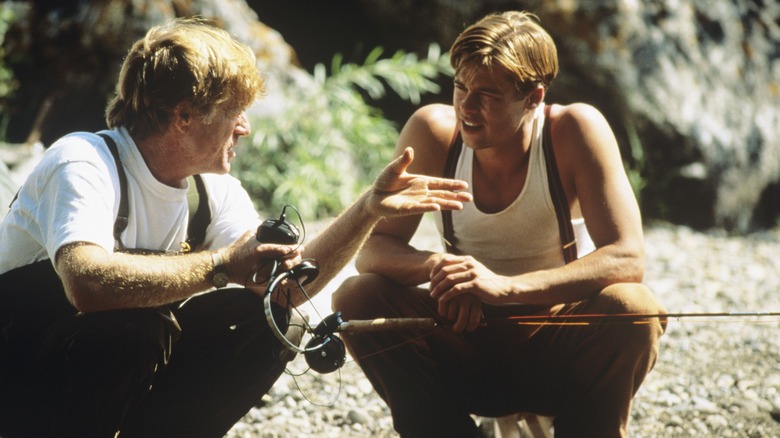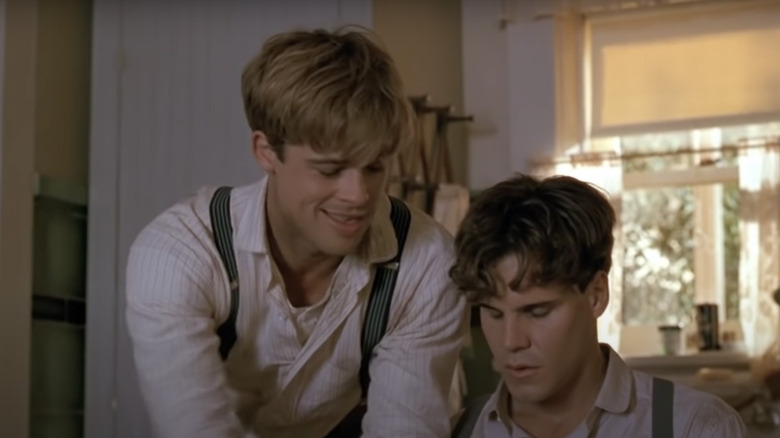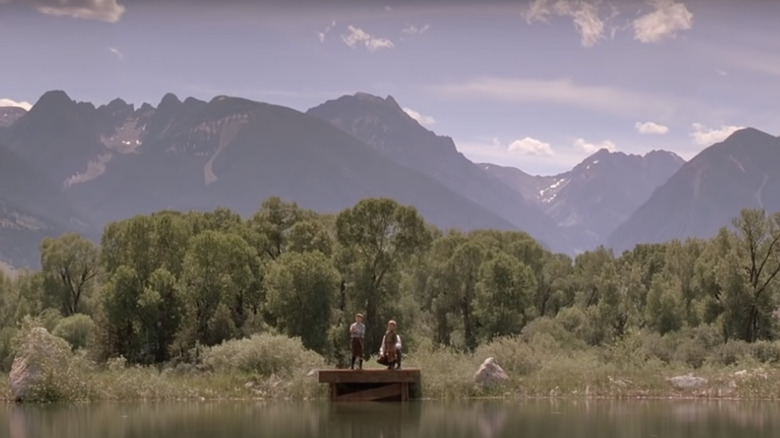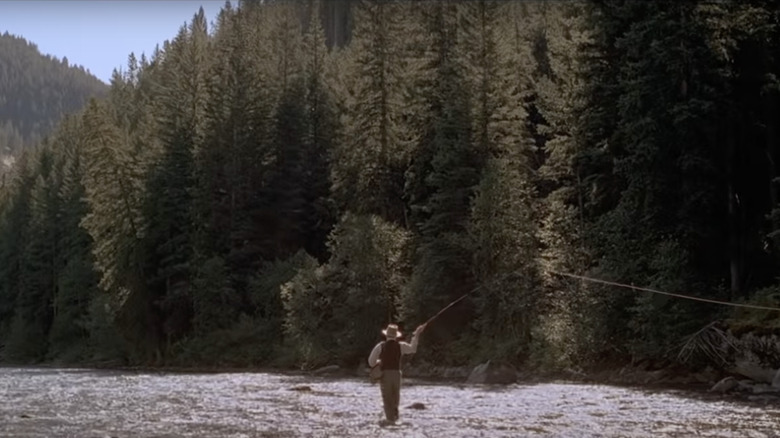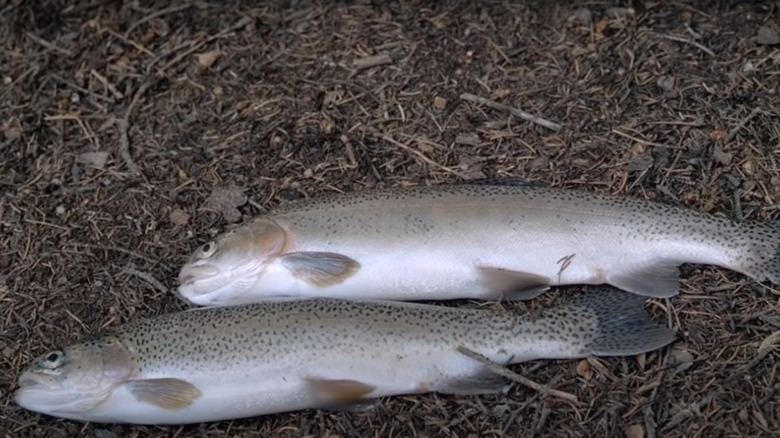The Untold Truth Of A River Runs Through It
Encapsulating the American identity — with all its struggles, joys, and quirks — has been a Sisyphean task of many artists, writers, and filmmakers since, well, the country's independence. (Aside from the filmmaking, of course; that came later.) And the beauty of such an impossible undertaking is that it's never finished. Times change, society shifts, people are complex, and so forth. However, many projects -– particularly in literature, several of which later became films –- have nestled near the triumphant designation as the Great American Novel, although no single piece of work holds the title indisputably.
One such work in the Great American Novel conversation, which shares the company of other literary giants like F. Scott Fitzgerald's "The Great Gatsby," Herman Melville's "Moby Dick," and Mark Twain's "Adventures of Huckleberry Finn," is Norman Maclean's semi-autobiographical 1976 novella, "A River Runs Through It and Other Short Stories." It tells the tale of Maclean's upbringing in Missoula, Montana during the early 20th century. Maclean and his brother encounter love, loss, career trouble, the Great Depression, the Prohibition era, and a lifelong connection to fishing. Yes, fishing is a huge part of the story. And later, in 1992, the book became an acclaimed film starring Tom Skerritt, Brad Pitt, and Craig Sheffer.
Decades since its release, and "A River Runs Through It" is still a classic, revered film. So, why not revisit it and learn about what happened behind the scenes, in the lead up to filming, and whether or not Brad Pitt was as good at fly-fishing as he portrayed in the film? (Spoiler: he wasn't.)
The film was based on a book
In 1976, author Norman Maclean's semi-autobiographical novella, "A River Runs Through It and Other Short Stories," became the first work of fiction published by the University of Chicago Press. As the legend goes, Maclean first sent it to prestigious New York publishing houses, only to get rejection after rejection. One editor, according to the LA Times, reportedly justified their choice not to publish it as such: "It has trees in it," as in it was too rural for their metropolitan readers. But the University of Chicago –- where Maclean got his graduate degree and later taught in the English department -– came to the rescue and brought the book to the masses.
Describing the book, from its plot to its resonance with readers, journalist Peter Dexter wrote for Esquire in 1981: "It is a story about Maclean and his brother, Paul, who was beaten to death with a gun butt in 1938. It is about not understanding what you love, about not being able to help. It is the truest story I ever read; it might be the best written." In addition to the Maclean family history, the book captures the atmosphere of his upbringing in the American West –- the racism, prohibition, financial woes from the Great Depression, religious fanaticism, and more. Then, there's the fishing. To get an idea of how important fly-fishing was to the era and Maclean family, here's the first line of the text: "In our family, there was no clear line between religion and fly-fishing."
The book went on to be for the Pulitzer Prize for fiction in 1977, it became a hit film, and it continues to be a beloved slice of Americana literature.
Brad Pitt actually learned how to fly fish
Fishing is life for the Maclean family. And so, in order to accurately portray the family on the silver screen, the cast of actors had to practice, well, their casting. Brad Pitt's character, Paul, is an exceptionally skilled fly-fisherman. Pitt enlisted the help of someone who knew what they were doing before shooting began: singer Melissa Etheridge.
"I love to fish," Etheridge told Access Hollywood Live (via Us Weekly). "I grew up in the Midwest and loved to fish, totally a huge fly-fishing [fan]." Etheridge is originally from Kansas, but she and Pitt were both living in Los Angeles at the time of the fly-fishing practice, so they had to get creative. "I taught Brad Pitt how to fly-fish in my swimming pool," she said. "So, there we are in Hollywood, in my pool, and I'm teaching him how to do it."
When asked if Pitt was a good fisherman or not, Etheridge said: "Well, he got the part! He did great." But director Robert Redford wanted to be as authentic as possible in telling the story, especially for the fishing scenes. And so, they brought in fishing consultants and stunt doubles on-set. (More on that later.) "I just taught him how to cast," Etheridge said on "The Dan Patrick Show." "[I showed him how] to look like he knew how to fly fish. And then for the movie, of course, the big professionals came in and taught him how to do everything."
It was Joseph Gordon-Levitt's debut film role
Today, Joseph Gordon-Levitt is one of Hollywood's top leading actors. But back in the early '90s, when "A River Runs Through It" was made, he was just an up-and-coming kid. And his role in the flashback scenes as young Norman was his first appearance in a major film.
Prior to "A River Runs Through It," Gordon-Levitt had guest appearances in TV shows (like "Family Ties," "Murder, She Wrote," "Quantum Leap," and others) and a small credit in the big, slobbering, St. Bernard-starring 1991 film, "Beethoven." But "A River Runs Through It," where he worked with legendary actor-turned-director Robert Redford, was by far his biggest role to date. Of course, Gordon-Levitt would go on to become a very recognizable name in Hollywood -– from starring roles in indie darlings like "Brick" and "500 Days of Summer" to big-budget blockbusters like "Inception" and "The Dark Knight Rises."
In a journal entry about his time on "A River Runs Through It," Gordon-Levitt wrote: "My mom and I lived in Livingston, Montana for about six weeks. I was ten. Saw the biggest sky I'd ever seen. Hopped on rocks through ice cold rivers. Learned a proper fly fisherman's cast. But mostly I remember the motel's pinball game. Black Knight 2000. I guess nothing beats blinking lights. We might be in trouble."
The film was a boon for the fly-fishing industry
The Maclean brothers are avid fly-fishermen in both the book and film versions of "A River Runs Through It." And the river, by way of fishing, serves as a metaphor for life's biggest milestones that the brothers face. As Maclean writes in the novel, "It is not fly fishing if you are not looking for answers to questions."
Following the popularity of the book and subsequent film, interest in fly-fishing skyrocketed. According to Forbes, the fly-fishing industry saw a 60 percent increase in both 1991 and 1992.
What's more, Montana –- where the film and book take place –- saw a boost in tourism and especially flocks of visitors coming to fish, for better or worse. Norman Maclean's son John told the Billings Gazette that "It certainly changed fly-fishing, and it probably changed the state of Montana. The Blackfoot became almost un-fishable after it came out -– there was a cavalcade of boats after the movie. It was like the Spanish Armada going down the Blackfoot."
But years after the movie, efforts were made to restore the Blackfoot River to its former glory -– or at least close to it. John Maclean continued by saying that fishing in the Blackfoot "is as good as it's been in my lifetime. It's not as good as it was at the start of the 20th century when my father fished it, and it never will be. But millions of dollars were poured into restoring the river and its tributaries because of the movie."
Location inconsistencies
The book and film of "A River Runs Through It" are set in Missoula, Montana, but filming took place in Livingston, Montana. Also, the fishing for the film went down on the Gallatin River, not the Blackfoot River, as in the book.
Director Robert Redford's reasoning behind this was because, at the time, the Blackfoot River suffered from industrial pollution and overfishing. Additionally, Missoula was too modern, too built-up to serve as a suitable stand-in for the 1920s-era of "A River Runs Through It." And so, they opted for a more rural setting and a better fishing destination for shooting in Livingston and the Gallatin River.
Despite the location inconsistencies between the book and film, tourism to Montana as a whole exploded – as mentioned above. As a result, when Redford returned to Montana a few years later to shoot "The Horse Whisperer," he left the shooting location intentionally vague. "He decided he didn't want to pinpoint where we filmed because he wanted to protect the seclusion of that special place," film publicist Kathy Orloff told the Billings Gazette. "He was hurt when he was criticized for the attention 'River Runs Through It' brought to the state."
Brad's big break
Although he appeared in minor roles in previous films, this was Brad Pitt's first major leading role, landing him subsequent starring gigs in the years that followed with films like "Interview with a Vampire," "12 Monkeys," and "Seven." It also led to his first Academy Award and Golden Globe nomination, which came two years later, from his role in another Montana-set drama, "Legends of the Fall."
Surprisingly, Pitt wasn't all too thrilled with his performance in "A River Runs Through It," despite the acclaim that he received as his first major starring role. "I felt a bit of pressure on 'A River Runs Through It,'" Pitt told Rolling Stone back in 1994 (yes, the issue that he adorned the cover with below-shoulder-length, caveman-inspired hair.) "And I thought that it was one of my weakest performances. It's so weird that it ended up being the one that I got the most attention for."
Prior to "A River Runs Through It," Pitt was a twinkle in the public's eye from a small part as a cowboy hitchhiker heartthrob in 1991's "Thelma & Louise." He also had a few guest appearances in TV series like "Growing Pains," "21 Jump Street," "Glory Days," and an unnamed cameo as a partygoer in Brett Easton Ellis' novel-turned-film, "Less Than Zero." Of course, today, Brad Pitt is at the top of the Hollywood hierarchy — and it all started from "A River Runs Through It."
Robert Redford worked hard to get the film rights
Following the success of his novella, Hollywood came a-knocking for Norman Maclean's "A River Runs Through It." But the film industry's fervor for the rights were only matched by Maclean's aversion to his semi-autobiographical tale getting the silver screen treatment.
Maclean had unkind words for studio executives and that he had no interest in making a film version of his life -– "not with my family, not with my stories," he reportedly said. After his death, his daughter Jean Maclean Snyder told the Los Angeles Times that "Truth is, Dad was both intrigued and repelled by the idea of a movie."
But then came Robert Redford. He connected with the book saying, "Norman's story is something that I knew and I felt. And so I've always seen the story as a vehicle to tell a history of the West, and also about how I was raised." But Redford still had to work for the rights, and convincing Maclean that he could do the story justice was no small task. "Norman was hard-nosed," Redford said. "The Montana guy and the University of Chicago guy –- they're both very tough traditions, in their own ways. I respected him enormously. And we worked hard at building trust. I didn't know him; he didn't know me. Finally, the trust is what did it."
Differences between the book and movie
Oftentimes, films based on books take liberties from the original text. This might happen because of convenience, casting, or the sheer impossibility to portray something in literature via a visual medium. "A River Runs Through It" is no different. There are a handful of disparities between the plot of the book and the one in the film -– most notably, the real Paul Maclean follows his brother Norman to Chicago, whereas in the film he stays in Montana.
In the movie, Paul Maclean laughs at Norman's suggestion that he come with him to live in Chicago; Paul says he'll "never leave Montana." The movie version of Paul went to a local college, got a job at a local paper, and ends up dying in Montana. But the real-life Paul graduated from and played football for Dartmouth, lived and worked in Chicago just like Norman, and was murdered in Chicago.
Another inconsistency between Maclean's life and the film is the timeline between events. For example, the film is compressed quite a bit from real life. In the movie, Norman came back to Montana in 1926. While watching the film, it makes it seem as though Paul's murder was very soon after he came back. However, in real life, Paul's death occurred 12 years later, after Norman returned home in 1938.
Pricey property
The natural beauty showcased in "A River Runs Through It" is one of America's most coveted pieces of real estate, as evidenced by a record-breaking sale for the region. The Climbing Arrow Ranch, where portions of the film were shot, sold in September of 2021 upwards of $130 million, making it the most expensive deal in Montana history according to the Bozeman Daily Chronicle.
The Climbing Arrow Ranch boasts 80,000 acres, 2,000 Black Angus cattle, petroglyphs from the Crow and Blackfeet Tribes, tunnels from a historic (now disused) railroad route, and much more. It was sold by the Anderson family, whose children put the property on the market following the passing of their parents. "We will cherish this for our lifetimes, and it can never be replaced," the Anderson children said, via the Daily Mail. "While we feel both pride and tribulation in this change, it is time to pass the reins to a new owner who will love and enjoy the ranch as much as we have."
Buyers of the Climbing Arrow Ranch have not been disclosed. However, a representative for the buyers, Bryce Connery, confirmed that the new owners will keep the natural beauty of the property the same. "They are not developers, so (the land) will be kept intact," he told the Bozeman Daily Chronicle. "They are absolutely going to enjoy the benefits of the immense recreational opportunities, but they will continue to run the cattle and be good stewards of the land."
Shadow cast, shadow stand-in
In one of the most famous scenes from "A River Runs Through It," Brad Pitt's character Paul Maclean stands on a rock and "shadow casts" for fish. It's supposed to be an extremely advanced technique, reserved primarily for the experts, although it was pretty much made up for the book as a vehicle to show how good Paul was with a fly-fishing rod. The act of "shadow casting" is supposed to put the fly just above the water. The hungry trout will see the shadow of the fly on the water, and it will jump in the air to catch it.
As it turns out, to make the shot look as real as possible, they decided to bring in a real expert. That was Jason Borger, the son of legendary fly-fishing teacher Gary Borger. And allegedly, according to fly-fishing magazine Fly Lords, a friend of the Maclean family was watching this unique style of casting and commented: "You are Paul."
Fish tales
Fishermen love making up a good story –- the one that got away, the great white whale, and so on and so forth. But when it came to the movie version of "A River Runs Through It," they were all just fish tales –- as in, no fish were actually "caught" during the filming.
For example, during fishing scenes, the lines were tied to fish in the water, instead of hooked. "Fly fishing was the core of the movie," John Bailey, a fly-fishing consultant on the film, told The Great Falls Tribune. "It had to work." And because it had to work, along with a "no hooks" policy from the Humane Society, which was on set to supervise, "We tied 'em on," Bailey said. When asked how, exactly, they would tie a line to a fish, Bailey kept his secret close: "There has to be some mystery in the movie business, doesn't there?"
There were also fake fish used during filming. Yes, fake, mechanical fish. But according to filmmaker Dennis Aig, "The mechanical fish just couldn't take the river." The fake fish did make it into the movie, however. But that was a bit of movie magic, because, instead of going down in a river where the characters are supposed to be fishing, this "catch" took place in a pond.
